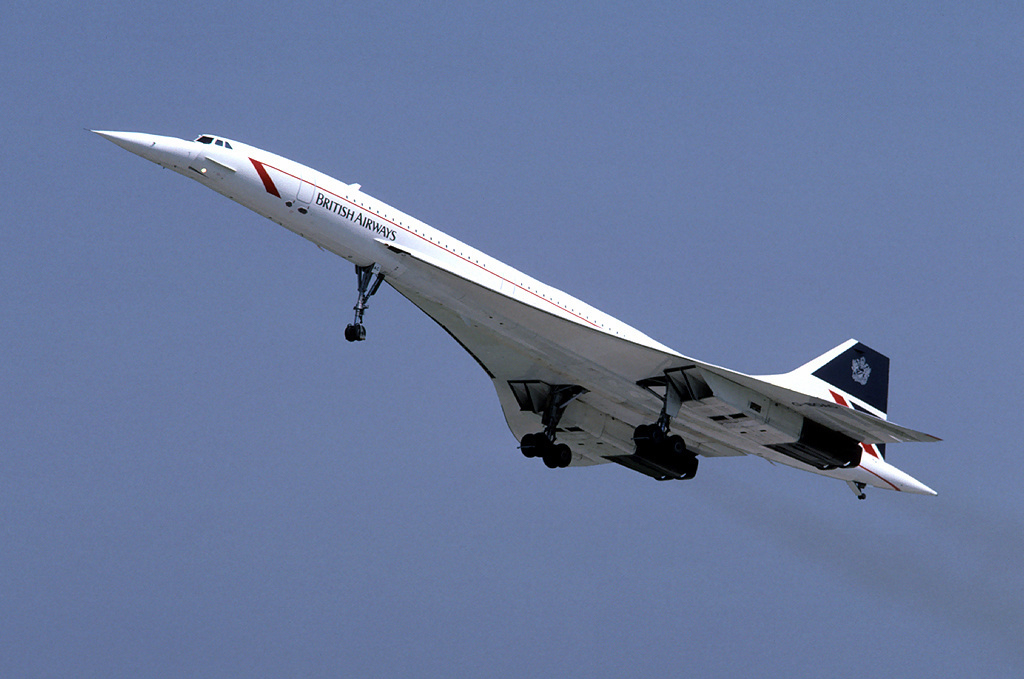The popularity of the phrase “style over substance” has encouraged us to assume an inherent and absolute divide between those concepts. But as the most ambitious works of man remind us, style pushed to its limits its substance, and vice versa. This truth has been expressed in various specialized ways: architect Louis Sullivan’s maxim “form follows function,” for example, which went on to attain something like scriptural status among modernists of the mid-twentieth century. It was in that same era that aerospace engineering produced one of the most glorious proofs of the unity of style and substance, form and function, mechanics and aesthetics: Concorde, the supersonic jetliner that flew between 1976 and 2003.
Nobody who flew on Concorde (colloquially but not officially “the” Concorde) has forgotten it. The sharpness and length of its ascent; the thrust of the after-burner, pressing you into your seat like the acceleration of a high-performance sports car; the visible curvature of the Earth and the deep purple of the sky; the impeccable food and drink service that turned a flight between New York and London into a sumptuous French meal. A host of former passengers, crew members, and pilots reminisce vividly about all this in the BBC documentary Concorde: A Supersonic Story. That story is told more briefly in the Vox video at the top of the post, which asks the question, “This plane could cross the Atlantic in 3.5 hours. Why did it fail?”
The short answer has to do with business viability. At supersonic speeds an aircraft leaves a sonic boom in its wake, which relegated Concorde to transoceanic flights. Its inability to hold enough fuel to cross the Pacific left New York-London, operated by British Airways, as its sole viable route, with Air France also running between New York and Paris. For Concorde was an Anglo-French project, launched as a partnership between the two governments in 1962, at the height of the Space Age — and despite enormous subsequent cost overruns an effectively un-cancelable one, since one country couldn’t pull out without the other’s say-so.
With national pride at stake, French commitment did much to make Concorde what it was. “Because it went so fast, the V.I.P.s on board wouldn’t need much more, from an English point of view, than a sandwich, a cup of tea, and a glass of whiskey,” says Jonathan Glancey, author of Concorde: The Rise and Fall of the Supersonic Airliner. But the French said, “No, this a luxury aircraft,” and it was ultimately luxury — as well as a sleekly functional silhouette that never stopped looking futuristic — that kept Concorde going until its retirement in 2003. (Nor could the convenience factor be ignored, for investment bankers and international celebrities alike: “It’s always exciting to get to New York before you’ve left,” said frequent flier Sting.)
“The real flaw in Concorde was not technological but social,” writes Francis Spufford in the London Review of Books. “Those who commissioned it assumed that air travel would remain, as it was in 1962, something done by the rich: and not the mobile, hard-working managerial rich either, but the gilded upper-crust celebrity rich,” the original “jet set.” Alas, the future lay not with speed but volume: “The Boeing 747 was just as bold a leap into the unknown as Concorde, just as extreme in its departure from the norm; nothing so large had ever left the ground before. And Boeing’s gamble paid off.” Supersonic jetliners have nevertheless re-entered development in recent years, and if any come to market, they’ll surely do so with such luxuries unknown in the Space Age as personal, on-demand entertainment systems. But will anything they can show be as thrilling as Concorde’s cabin speedometer reaching mach two?
Related content:
An Animated History Of Aviation: From da Vinci’s Sketches to Apollo 11
NASA Captures First Air-to-Air Images of Supersonic Shockwaves Interacting in Flight
Based in Seoul, Colin Marshall writes and broadcasts on cities, language, and culture. His projects include the Substack newsletter Books on Cities, the book The Stateless City: a Walk through 21st-Century Los Angeles and the video series The City in Cinema. Follow him on Twitter at @colinmarshall, on Facebook, or on Instagram.
